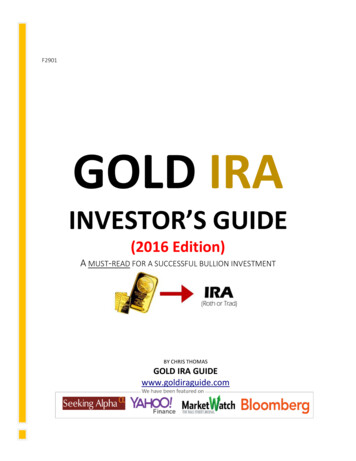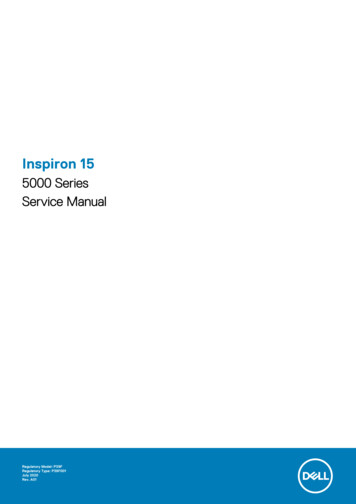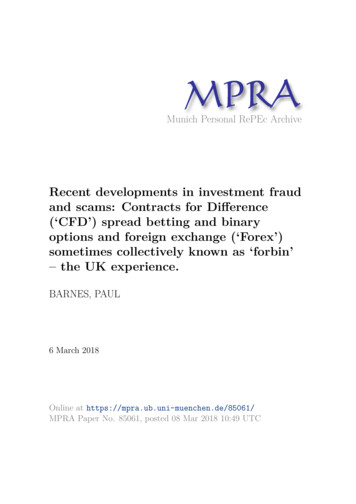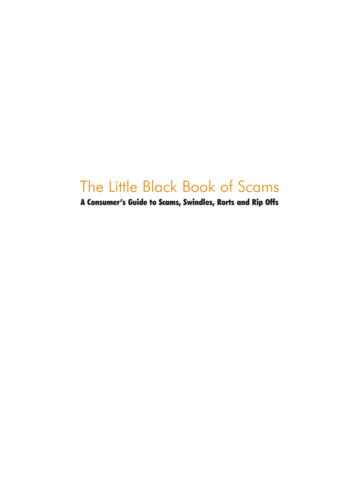
Transcription
F2901GOLD IRAINVESTOR’S GUIDE(2016 Edition)A MUST-READ FOR A SUCCESSFUL BULLION INVESTMENTBY CHRIS THOMASGOLD IRA GUIDEwww.goldiraguide.com
Table of ContentsTable of Contents . 0Preface – Beware of Gold Scams! . 21. Glossary of Important Terms . 32. What to Look For When Investing in a Precious Metals IRA . 5A) The company you'll be buying the bullion from:. 5B) The custodian in charge of storing your gold in a depository: . 63. Top Five Gold Scams in 2016 . 7Scam #1: The Bait-and-Switch: Advertise Bullion, Upsell Numismatics . 7Numismatics Cannot Be Deposited Into a Precious Metals IRA . 8Dealers Charge Absurd Commissions on Numismatic Coins . 8The “Numismatics Can't Be Confiscated” Con . 9Numismatic Coins Have Very Low Liquidity. 10Few Numismatic Coins Will Appreciate in Value . 11Scam #2: The “Investment-Grade” Farce: Higher Prices for Graded/Certified Bullion Coins .11Scam #3: Pressured Into Converting All or Most of Your Savings Into Precious Metals .12Scam # 4: Talked Into Opening “Leveraged” Accounts .13Scam #5: Financial Advisors Taking Excessive Commissions .154. Understanding Prices in Gold Transactions . 165. Questions to Ask Before Buying Gold for Your IRA. 176. The Different Allocations for Precious Metals . 18Strategy #1: Lightly Allocated in Metals .18Strategy #2: Moderately Allocated in Metals .18Strategy #3: Heavily Weighted in Metals .197. Review Different Companies Before You Invest! . 19Gold IRA Investor’s Guidewww.goldiraguide.com1
Preface – Beware of Gold Scams!With the majority of financial analysts and economists warning investors about the highprobability of another financial crisis, the 18 trillion national debt, the continuedcurrency debasement policies, and hyperinflation appearing imminent in the nextdecade, most experts expect to see a continued increase in the demand for and price ofgold, silver and other precious metals.In addition to retirement investors flocking to gold to protectthe value of their wealth, we've also seen an exponentialincrease in the number of unscrupulous bullion companies thatintend to profit from the modern “Gold Rush” by exploitinguninformed investors with shady business practices, forcefulsales tactics, and unfair/hidden fees.Scams are easy to spot if you know what to look for, but to theinexperienced investor under the influence of a fast-talking salesman or impressive webpage, it's not always easy to differentiate between a reputable bullion provider and aprofit-driven middleman that charges excessive premiums.Companies that perpetuate precious metals IRA scams capitalize on the growing demandamongst retirement investors by redirecting their zeal and convincing them to purchaseproducts that are either overpriced or poor investments altogether. Oftentimes suchproducts are sold at prices far above the fair market value of their precious metalcontent, and in some cases the coins are not even eligible to be deposited into a preciousmetals IRA.This comprehensive report reveals some of the most common scams and schemes usedby unscrupulous dealers, financial advisors, advertisers, and investment firms operatingwith the sole intention of increasing their profits by tricking you into overspending and/or“investing” in products and services that no serious investor would ever consider.In this document we'll teach you how to steer clear of the industry vultures andeffectively make a well-informed buying decision when investing in a precious metals IRA.But first, let's look at some of the lingo you'll need to become familiar with in order totruly understand the extravagant sales pitches and promises made by the mostpersuasive precious metals scammers:Gold IRA Investor’s Guidewww.goldiraguide.com2
1. Glossary of Important TermsBullion – Bars and coins that meet set purity standards and are officially recognized byglobal markets. According to the London Bullion Market Association (LBMA), gold bullioncoins must be at least 99.9% pure and gold bullion bars must be at least 99.5% pure.Examples of popular gold bullion coins include: American Gold Eagle American Gold Buffalo Canadian Gold Maple Leaf Australian Gold Kangaroo Austrian Gold PhilharmonicAppreciation/Depreciation – The rate at which the value of an item increases(appreciates) or decreases (depreciates) over time. For example, if you purchase a cointhat costs 50 today, and in 10 years it is worth 100, that would mean it has appreciatedin value by 50, or 100% (of its original price).Historic Coins – Companies typically use this term to refer to coins that were minted andreleased before 1933. You may see sections on their websites that sell “Pre-1933” coins.Precious Metals IRA – A type of self-directed individual retirement account (IRA) in whichan investor can deposit gold, silver, and other precious metals in the form of bullion. Aprecious metals IRA in which gold is the primary investment is also commonly referred toas a “Gold IRA.”Gold IRA Investor’s Guidewww.goldiraguide.com3
Karats – The unit used to measure the purity of a precious metals product. Gold isconsidered pure at 24-karat, but most gold on the market is mixed down to 22-karats toincrease the strength of the metal.Liquidity – A measurement of how easily an asset can be sold for cash. An investmentwith high liquidity is easy to sell for a fair price in any marketplace, at any time. It isimportant to differentiate between liquidity and value – sometimes an item can be morevaluable, but much harder to sell.Mark-up – The difference between the cost a dealer pays for precious metals from theirwholesale supplier and the retail price they charge their customers. For example, if adealer buys gold from their supplier at 2% above the spot price, and sells the samecoin/bar at 6% above the spot price, then their total mark-up is 4 percentage points.Premium – The cost of any precious metals product in addition to the current spot priceof its precious metal content. For example, if gold is selling at the spot price of 1,200 perounce, and the dealer is selling a 1-ounce bar for 1248, which would mean theirpremium is 48, or 4% of the spot price ( 1200).Mint State – A rating that measures the condition and quality of a coin, ranging from MS61 to MS-70.Numismatic Coins – These coins, which best serve as collectors' items and gifts, differfrom bullion coins because their value is based on their rarity, condition, and mint date,rather than the actual value of the precious metals they contain.Spot Price – The live price that financial institutions pay for one ounce of precious metalsfrom a major bullion exchange. This is essentially the wholesale price, or the price thatthe precious metals wholesaler pays for their stock. The wholesaler adds a premium tothe spot price before selling to the retailer/dealer, who then sells the products toindividual investors after adding their own mark-up. Most dealers show the live spotprice on their website to help you determine how high their markups are. See thedefinition of “mark-up” above.Spread – The difference between the price a dealer sells their precious metals for and theprice they will buy them at. This is one of the most important factors to consider whencomparing companies. A good dealer will have a low spread – meaning they will buyprecious metals at a price that is close to the price they sold them at.Gold IRA Investor’s Guidewww.goldiraguide.com4
Troy Ounce – The standard imperial (English) measurement unit used to measure theweight of precious metals. One troy ounce weighs approximately 31.1 metric grams.Now that you've become familiar with some of the main terminology you'll encounterwhen researching precious metals companies, let's get started.:2. What to Look For When Investing in aPrecious Metals IRABefore introducing the scams and tactics that are most commonly employed bycompanies you're trying to avoid, we'll start by showing you what to look for in thecompanies that you are trying to find. There are two types of companies that investorswill typically have to compare when investing in a precious metals IRA:A) The company you'll be buying the bullion from:First you'll want to find a reputable precious metals dealer that doesn't charge unfairfees, commissions, or premiums. Preferably, if you're planning on investing in a Gold IRA,you should deal with a provider that can help you set up, fund, and directly deposit yourbullion into, your precious metals IRA. You can use the following basic checklist to askand answer the questions needed to make an informed investment decision whenchoosing a bullion dealer/Gold IRA company: What is their reputation like? (Both online and offline)Check their rating on leading business directories and ratings bureaus like the BetterBusiness Bureau, Business Consumer Alliance, Trustlink, Yelp, Yellow Pages, and Google .A great company that satisfies its clients will have a high number of positive reviews onmultiple sites. Do they assist in the process of setting up and funding a Gold IRA? Do theymake it easy to deposit the purchased bullion directly into a precious metalsIRA?Gold IRA Investor’s Guidewww.goldiraguide.com5
If they do not, you'll have to set up your own IRA with the custodian of your choice, andthen you'll have to ensure that your bullion dealer will be able to provide delivery of theprecious metals into the IRA you've set up. Look for leading bullion dealers that havedevoted sections of their websites to precious metals IRAs and have establishedpartnerships with the leading custodians to streamline and safegaurd the investmentprocess. What are their main products and how do they try to sell them? Are theytrying to sell you numismatic/collector's/pre-1933 coins when you're askingabout products for your Gold IRA?Be wary and steer clear of aggressive sales pitches and companies that are quick torecommend any products other than bullion when you're inquiring about products foryour Gold IRA. This is a clear sign that they are just trying to earn higher commissions andmore profit from your purchase. Are they able to provide offshore storage solutions?This is a feature that only the best bullion dealers and Gold IRA companies haveimplemented for the benefit of their clients. A company that is actually concerned aboutthe security of their clients will go the extra mile to partner with storage providers whohave offshore facilities in places like Hong Kong, Singapore and London.To learn more about comparing Gold IRA companies and bullion dealers, see ourcompany comparison chart.B) The custodian in charge of storing your gold in adepository:The other type of company that you'll need to pay attention to when setting up a selfdirected precious metals IRA, is the custodian that will act as the trustee of the account.Here are some questions that should be answered when comparing custodians: Do they charge flat-rate storage and admin fees, or do they charge sliding scalefees?Gold IRA Investor’s Guidewww.goldiraguide.com6
Sliding scale fees increase along with the fair market value of the precious metals storedwithin the account, whereas flat-rate fees stay the same regardless of the value of theaccount. Do their annual fees include the cost of storage, or do you have to pay a storage feeto the depository based on how much metals are stored in the account?Some custodians will charge a flat-rate fee for storage, making it easy to determine theoverall annual cost. Other custodians will give you a choice of which depository you'd liketo use, and your storage costs would then depend on the storage fees charged by thatdepository. Which depository do they use, and do they let you choose your own depository?Being given the choice to choose your own depository is not always as great as it mayseem. Do you feel confident that you'll choose the most cost-effective and safestdepository? You may be better off dealing with a company that has established a costeffective partnership with a leading custodian.3. Top Five Gold Scams in 2016Now that you've become familiar with some of the positive traits to look for in a bulliondealer and custodian, without further ado, let's take a closer look at some of the moreprevalent scams and scam-like activity seen in the precious metals industry:Scam #1: The Bait-and-Switch: Advertise Bullion,Upsell NumismaticsThis is by far the most common way metal dealers convince investors to pay more thanthey should for precious metals. In fact, most dealers earn the majority of their profits byselling numismatic coins, not bullion coins, even though bullion coins are the only kind ofcoin an investor should buy. Many unsuspecting retirement investors have purchasednumismatic coins only to later find out that they're not even eligible to be deposited intoan IRA.Gold IRA Investor’s Guidewww.goldiraguide.com7
Once you're actually on the phone with one of the company's sales reps, they'll then tryto persuade you into buying numismatic coins instead, falsely hyping up their value withterms like “historic,” “rare,” “limited,” etc. Recommending products other than, or inaddition to the items a buyer is interested in, is a practice called upselling – one of thekey signs that a company is just looking to earn extra profit from your investments. Theywant to sell you something extra or something different, despite the fact that you don'tneed it.The fact is, unless you're a highly knowledgeable coin collector and/or you happen topurchase some of the few numismatic coins that actually do appreciate in value, there are anumber of reasons to completely avoid numismatics:Numismatics Cannot Be Deposited Into a Precious Metals IRAThe most important and straightforward reason for retirement investors to avoidnumismatic coins is that they're not eligible to be deposited into a precious metals IRA.Plain and simple, if you're looking for investments for your self-directed IRA. you'll needto completely steer clear of numismatic coins and companies that try to upsell themwhen you're asking about bullion. The very first thing an investor should learn wheninvesting in a precious metals IRA is that only certain bullion coins are eligible to bedeposited into an IRA.Dealers Charge Absurd Commissions on Numismatic CoinsDealers typically sell numismatic coins at prices that are 35% to 50% higher than theactual value of the precious metals they contain. Huge profits for them! Unfortunately,most numismatic coins will never appreciate in value enough to account for thecommission alone, and even those that do, typically take decades to increase in value.You could be waiting twenty years just to see a 50 coin become worth 50 again, andanother 20 years to see it become worth 100, and that's if the coin ever becomesprofitable at all.We should clarify that there's a relatively tiny number of elite numismatic coins thatdemand a high price as rare collector's items. Those coins can be worth lots of money (inrare cases even 100,000 ), and when the economy is good and there are buyers, it mayGold IRA Investor’s Guidewww.goldiraguide.com8
be possible to liquidate them, but such ultra-rare, high-value coins cannot be bought inbulk as investments and are considered to be more like antiques/art.The “Numismatics Can't Be Confiscated” ConSome precious metals dealers will try to use a common scare tactic that we like to call theConfiscation Con. They tell the investor that numismatic coins are the only types of coinsthat are “exempt from government confiscation.”This entire argument is based on a law passed back in 1933 by President Roosevelt –Executive Order 6102, which prohibited US citizens from privately holding gold. The lawrequired gold owners to turn over their gold bullion or face a 10,000 fine (which wouldamount to 167,700 in today's dollars) and/or 10 years imprisonment. The “numismaticscan't be confiscated con” comes from the following exemption in the law:“Gold coin and gold certificates in an amount not exceeding in the aggregate 100 [about5 troy ounces at that time] belonging to any one person; and gold coins having arecognized special value to collectors of rare and unusual coins.”Salesmen like to highlight the words “rare and unusual” to convince potential byers thattheir numismatic coins would be exempt in the event of a government confiscation.Maybe in 1933 this could have been a cause for concern at first glance, but even then atthe height of the Roosevelt confiscation there were no cases of the government breakinginto people's homes and safes to forcefully take their gold.The law didn't state “turn in all your gold, or we will come take it from you,” it stated“turn in in all your gold or you could face a fine and/or be prosecuted.” There was onlyone case of prosecution under the order, which took place when a lawyer in New Yorkattempted to withdraw 5,000 troy ounces of gold at Chase Bank, and ironically the courtdid not even convict him for it.When it comes down to it, if the government were to start confiscating property foreconomic reasons, they'd probably start with assets that like real estate, vehicles, andstock and bond certificates first, all of which would be much easier to seize than gold. Ifthat starts happening you'll have a lot more to worry about than whether the numismaticcoins in your collection will be safe from the TSA officer that would hypothetically betasked with job of seizing your gold. Do you think that shouting “hey, don't touch those,they're numismatic,” would work to keep them in your possession in a scenario like that?Gold IRA Investor’s Guidewww.goldiraguide.com9
The reality is, the vast majority of numismatic coins would under no circumstances beconsidered “rare or unusual” enough to be excluded from a confiscation, which may ormay not ever occur. Note that the law does not mention the term “numismatic” at all.A lot of salesmen will try to talk you into purchasing what is commonly referred to as“pre-1933” coins, which are allegedly the “only coins exempt from confiscation.” This istotal nonsense to the point of being comical, because more than 95% of the gold thatwas “confiscated” during the devaluation of the dollar in 1933 were gold coins that wereminted before 1933. Most of the gold was willingly exchanged at the bank for papermoney at the rate of 35/ounce, which at the time was a 15 increase above the 20.67/ounce value that gold held prior to the confiscation scheme.Many gold holders proudly brought their gold in and exchanged it for cash in a patrioticgesture, standing behind Roosevelt's proposed plan to fix the economy. This is not thepicture painted by aggressive and misinformed salesmen that try to scare you into buyingnumismatic coins by making you believe the hyperbole that the government is going tokick down your door (or rob your bank?) and “confiscate” your bullion coins.Numismatic Coins Have Very Low LiquidityThis means that there are relatively few individuals and companies that will buy yournumismatic coins from you if you ever decide to liquidate them into cash, so you'reessentially stuck with them in most cases.There is no easy market for selling numismatic coins; oftentimes the dealer who soldthem to you will only buy them back at a price that is lower than what you paid for them.To the contrary, bullion coins are readily accepted and purchased at close to spot price ininternational markets around the world.An investor should never have trouble turning physical precious metals into cash. Goldand other precious metals have consistently ranked as some of the most liquid assetsthroughout history. The fact that numismatic coins are so difficult to sell for a fair price,despite their precious metals content, is a testament to how horrible of an investmentthese coins really are.Gold IRA Investor’s Guidewww.goldiraguide.com10
In fact, numismatic coins quite possibly have the lowest liquidity of any form of preciousmetals in history. Bottom line is, they're usually hard to get rid of, and if you do find abuyer, you'll be lucky to get back what you paid in most cases.Few Numismatic Coins Will Appreciate in ValueFinally, perhaps the biggest reason to avoid numismatic coins and companies that try topush them on you – they're practically worthless as “investments.”If you were to listen to the smooth sales rep at the average coin dealer, you'd probablyfall under the false impression that “numismatics can be more profitable than bullioncoins.” This is a blatantly misleading claim that salesmen often try to bolster with chartsthat are purposefully built to highlight the tiny minority of numismatic coins that havedone well in the past.Of course, such lucrative numismatic coins are only hand-picked in hindsight, and theirsuccess is certainly not typical of all numismatic coins. In fact, it is extremely unlikely thatyou'll be one of the lucky individuals that invests in the few numismatic coins that couldeventually become worth more than the price they were purchased for. Numismaticcoins are speculative, high-risk investments at best.In fact, if you compare the performance of rare numismatic coins graded by theProfessional Coin Grading Service (as indicated by the PCGS 3000 index) with the spotprice of gold bullion over the past decade, it's easy to see that numismatics have actuallymissed out on most of the price gains that gold has achieved in the past decade.Scam #2: The “Investment-Grade” Farce: HigherPrices for Graded/Certified Bullion CoinsThis is yet another common scam tactic used by some bullion dealers to trick buyers intopaying jacked up prices for completely unnecessary and overpriced certification. We'llexplain:Coin grading services like the American Coin Club Grading Service (ACCGS) and theProfessional Coin Grading Service (PCGS) give collectors a way to have their coins gradedGold IRA Investor’s Guidewww.goldiraguide.com11
and certified by a professional. The coin's condition is graded on a 70-point SheldonScale, with the highest grade being Mint State 70 (MS-70).These are indeed useful services for collectors of rare coins, especially in the case ofolder, more valuable pieces. For example, a coin from 1850 that is graded MS-70 wouldobviously have a much higher value than a badly worn coin from the same year.However, when you're buying brand new bullion for your Gold IRA, the condition of thecoins is a moot point because all of the coins and bars you buy will be in flawlesscondition.If you were to purchase a bunch of American Gold Eagles for your precious metals IRA,the coins would all be in MS-70 condition, and they would ship directly to a securedepository, where their condition is unlikely to change any time soon. But that rationaledoesn't stop bullion dealers from offering overpriced and overhyped “certified” versionsof freshly minted bullion coins.It's not uncommon to see bullion dealers charging 50- 80 extra for the graded versionsof new bullion coins. Meanwhile, it costs about 9 to have a coin graded by the sameservices yourself. For example, a 1 oz. 2014 American Gold Eagle might cost 1,255without grading, or 1,325 with the grading. Graded bullion coins might as well becollectibles, because no serious investor would willingly short themselves of 50- 75extra on each coin for certification, when they could have the coins certified themselvesat only 9 extra per coin.Plus, there really is no point in paying the extra money for certification when you knowfor a fact that brand new bullion coins ship in MS-70 condition. Paying more than 50extra per coin for a certification that should cost less than 10 is just a bad investmentdecision, yet there's no shortage of companies that try to convince their clients intodoing just that.Scam #3: Pressured Into Converting All or Most ofYour Savings Into Precious MetalsAnother common tactic used by profit-driven salesmen in the precious metals industry, isto convince the client that their entire portfolio is essentially at risk unless it isimmediately and entirely converted into precious metals. They'll want you toimmediately convert 60, 80 or even 100 percent of your retirement savings into aGold IRA Investor’s Guidewww.goldiraguide.com12
precious metals IRA. Any company that wants you to empty out your entire retirementaccount into a precious metals IRA is obviously not acting in your best interest.Investment is, and will always be, about balance! No one should recommend that you putall your eggs in the same basket.A respectable and knowledgeable IRA investment specialist would never instruct a clientto convert all or most of their assets into gold or any other single asset type. Instead,most financial advisors recommend allocating between 5% to 25% of your retirementsavings towards precious metals, depending on the level of risk you're willing to take,your investment goals, and your confidence in the economy and the strength of thedollar. See the section #6 of this document to learn more about some of the most effectivemetal allocation strategies.If precious metals are so safe, why not convert all of your assets to them? Retirementinvestors need to use their savings wisely to generate a maximum return, and while thereis a possibility that precious metals could provide a substantial return in the next decade,it is never a good idea to put all of your eggs in one basket.We would not recommend devoting more than one third of your portfolio to preciousmetals investments in most scenarios. The reasoning is that, although precious metals actas a great hedge against inflation and carry the potential to increase in valueexponentially, they may not be the most profitable investments in the short-term, andthey will not create residual income for you in retirement like some other investmentscan.Diversifying your portfolio is the best way to protect the value of your savings while alsoensuring an ideal return. The takeaway here is: be weary of salesmen that try toconvince you to convert more than one third of your retirement savings to a preciousmetals IRA.Scam # 4: Talked Into Opening “Leveraged” AccountsInvesting in so-called “leveraged” accounts is perhaps one of the most costly mistakes aninvestor can make. What is a leveraged account, you ask? It is an account in which adealer offers to lend you money to buy additional gold on top of your cash investment.So for example, if you plan to invest 10k in gold, the dealer may offer to loan you 20k 40k to purchase additional bullion that will be stored in the account.Gold IRA Investor’s Guidewww.goldiraguide.com13
They may emphasize the point that “since the value of gold is likely to rise, you might aswell maximize your return by borrowing funds to purchase more gold.” On the surface itseems logical, but then you learn about the seemingly unsurmountable gauntlet of feesthat could even leave you in a position to take a loss.Before we proceed, we should note that these accounts are useless to you if you're tryingto invest in a precious metals IRA, so avoid them altogether. Even if you're investing ingold outside of an IRA, consider the following:Here's an example of what could go wrong when using leveraged accounts:You want to invest 10k in gold. The dealer offers to loan you 20k more to purchasemore gold in a “leveraged” account. You agree and now you control 30k in gold withinyour account, but you only had to pay 10k up front. Sounds great, right? Suddenly goldexperiences a short-term correction (temporary price drop) of 20%, placing the totalvalue of your gold holdings at 24,000.Unfortunately, the dealer that talked you into the leveraged account probably didn'tmention, or emphasize (or maybe you even overlooked) the fact that they'll be needingadditional funds from you as a “margin call” to keep the account active, being that theirloan (which in this case accounted for two thirds of the account), is now in jeopardy.If they request a margin call of 2,000 as a security, and you're unable to furnish thosefunds in time, they close the account, take their full loan of 20k back and leave you withthe remaining 4,000. You just lost 6,000 on a gold investment because you wereunable to pay the margin call after a short-term correction.Normally, if you were holding the bullion yourself and had not taken out a loan to buytwo thirds of it, you would just hold onto your gold and wait for the price to s
Gold IRA Investor’s Guide www.goldiraguide.com 2 Preface – Beware of Gold Scams! . gold, silver and other precious metals. . Preferably, if you're planning on investing in a Gold IRA, you should deal with a provider that can help you set up, fund, and directly deposit your bu










